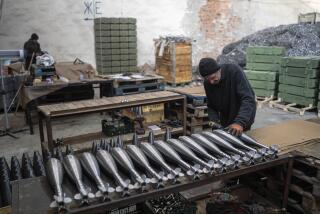Q: How Many U.S. Defense Labs Design Missiles? A: Too Many : Defense: Each branch of the armed services has research laboratories to design weapons. But that doesn’t mean we’re getting better defense systems.
WASHINGTON — Early last month, the University of Texas at Austin held the grand opening ceremony for a private research center to explore ways the U.S. Army can use high-speed guns to blast through tanks and launch satellites into space.
It sounds like a great idea.
It is.
But the Army already has research teams studying these weapons. So do the Air Force and the Navy. Each of the armed services has its own multimillion-dollar program to design these powerful cannons and test them on high-tech firing ranges. But that’s only the beginning.
Instead of concentrating resources on a handful of promising technologies, hundreds of military research programs struggle along. Researchers complain that they never get enough time or money to do the job right.
This has led to more than one fiasco. About 10 years ago, an Army laboratory attempted to design camouflage fatigues that could repel the heat of a nuclear blast. Instead, scientists were forced to surrender to the power of hot water. The fatigues shrunk so much that the soldiers could not walk and the sleeves shrunk up to their elbows. The uniform disaster and other research center bloopers are the result of a system gone haywire. Common sense is sorely lacking.
There are dozens of redundant efforts going on in the military laboratories and research centers. Taxpayers are footing the bill for nine government centers to design guided missiles, eight that work on lasers, 15 conducting medical research, eight exploring environmental issues and six studying psychology. And that is the Defense Department’s own tally. Add to that an enormous number of smaller projects that overlap.
For instance, the Army, Navy, Air Force and Marines all fly helicopters and all plan to shoot guns and missiles from them. But instead of concentrating work on those guns and missiles in one place, it is scattered in half a dozen states. During the 1960s, the armed services invented 12 different fuses to set off bombs. By 1970, people in the defense secretary’s office told the military to quit the nonsense and pick one fuse. They forced the armed services to share many helicopter weapons. That rarely happens anymore, partly because it’s such a difficult task.
It has always been tough to persuade the four services to buy the same weapons. They argue that their needs are so different, they cannot possibly agree on one gun or airplane. While the Air Force worries about buying a fighter plane that is light enough to dart and dodge in a dogfight, the Navy needs planes sturdy enough to be catapulted from a carrier deck and sturdy enough not to corrode in the salty sea air.
Still, there is plenty of unnecessary duplication, particularly in the area of research. The Pentagon spends $8 billion a year on 68 laboratories across the country that are supposed to invent everything from lightweight helmets and indestructible pouches of frankfurters and beans to tiny bombs and treatments for serious burns. In the past, government laboratories were responsible for such engineering feats as the atomic bomb, jet engines and powerful radars. During the Vietnam War, for instance, 85% of the missiles used by U.S. forces were products of China Lake, the Navy’s weapon research center near Death Valley.
Since the Defense Department now has nine research centers studying bombs and missiles, one might assume the results would be much more impressive. But they aren’t. The Army tinkered for nearly 20 years with a missile that shoots out of a cannon and bursts open in the air, unloading a stream of baby bombs with parachutes (the soldiers call them bomblets) to rain down on tanks. It’s a complex system because the bomblets are supposed to figure out where the tanks are instead of blowing up bushes. Finally, the Army made it work. But the Air Force is not too interested. Its researchers are still trying to tackle this technology on their own.
The Army has even had conflicts within its own ranks. Two decades ago, when the chief of the Army’s tank center was trying to find a way to help his troops fight in the dark, three research teams proposed solutions. All were designing similar equipment in different laboratories. What’s more, they had no idea others were working along the same lines.
It wasn’t a matter of national security, but rather lack of coordination and oversight.
Whenever a new technology is in demand, military research teams jump into the fray. That is how the United States ended up with nine missile laboratories in the first place.
Missile research began during World War II, when Germany invented a pilotless airplane, the V-1 buzz bomb. The Germans filled it with fuel and sent it toward London. When it ran out of gas, the buzz bomb crashed, blowing up anything it hit. Although it was not sophisticated, the V-1 and its successor the V-2 demonstrated a whole new way of fighting. U.S. scientists were scrambling to come up with their own buzz bombs when the war ended. Once peace broke out, money for such research dwindled.
Then in 1957 the Soviets shocked the world with Sputnik. U.S. researchers were working on their own world-circling spaceship, but Sputnik disgraced them. The bad guys were ahead and the United States had to catch up fast. Suddenly, money was no object. Rocket and missile centers sprung up everywhere. No one wanted to be left out. As a result, funding was spread across all the missile projects. That still happens.
Even the supervision of the research facilities is spread out and duplicative. Redundant layers of management are set up to ensure that no one is stealing taxpayer dollars. Taxpayers lose out anyway.
Excessive regulations turn simple tasks into bureaucratic nightmares. One research director had to assign someone on his staff to work full time for four months just to fill out the forms needed to order six desktop computers. Then it took more than a year for the computers to arrive.
Defense Department officials know the military laboratory system is not working. Dozens of studies over three decades have discovered the same problems. A 1962 report prepared for Defense Secretary Robert McNamara revealed excessive paperwork and a 1968 review found duplication in military research. Early this year, Defense Secretary Dick Cheney set up a task force to consolidate the research centers. That effort, however, is bogged down in its own bureaucratic struggle.
The group has been told to devise a comprehensive plan for closing and merging research centers. The task is almost impossible. The Navy is not about to give up its own research facilities and trust the Air Force to design all the missiles and the Army isn’t about to trust either one.
It may seem crazy to open a private research center in Texas when the Defense Department is trying to close its own laboratories. But the military’s own centers are so deeply entangled in red tape and the annual struggle for funding that they have little time to create anything.
Since the electric-gun research is considered to be an important element in shaping future armed forces, the only way to ensure productive research is to conduct it outside the government laboratories. Scientists in Texas will perform only a fraction of the paperwork foisted upon military researchers. Even better, they won’t have to waste a lot of timeand energy fighting with the other services.
More to Read
Sign up for Essential California
The most important California stories and recommendations in your inbox every morning.
You may occasionally receive promotional content from the Los Angeles Times.










